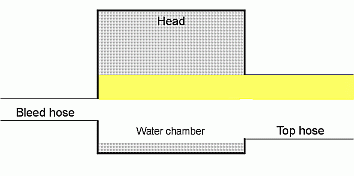Here's another one from me...... I know sometimes many of you think my posts,comments and suggestions are “Off the wall” and sometimes controversial and for that I apologise.
I have been doing some digging with chaps "in the know".....or rather garage owners/mechanic friends....
Why do the WL-T heads crack......? good question........ this seems to be a common fault with the WL-T engine(in all of vehicles it is used in) and most seem to crack between the valves, various schools of thought on why at that point (other than the heads are very thin at that point and prone to failure- I am told post 2001 Ford changed the head design and the Diesel Bongo finished at around that time) This head issue is not just a WL-T issue, other Ford engines are known to suffer in a similar way.
Some great ideas as to why the cracks happen have been put forward and now for some ideas, although no absolute answers, I have collected today from folks who spend their lives working on vehicles. I am not going to say who said what and from what type of garage, just an overview of what the Trade think....
One school of thought argues the overheating scenario, and suggests that poor coolant ratios and type among the reasoning, others even say that lubrication is part of the issue, by using the “wrong” grade even though factory recommended is used and saying that 10/40 the way to go as it is suggested that the lower grade oil gives reduced protection, by “running” away from protecting the head components and then the head therefore heats up more with less lubrication and less heat dissipation through the lubricant and in certain circumstances it has been known to find a snap camshaft..... they all suggest the thermostat is a weak area and should be changed with the coolant......as many of us on BF suggest.
So I guess you need to make your own mind up on this...as to why the cracks occur and I don't suppose there is an absolute answer as all overheating scenarios can and do have different factors...
No one I have spoken to has suggested that air locks cause overheating unless one of the above factors are played out which then results in an air lock being formed then "superheating" of the head with costly end results...
I guess regular Maintenance is the key as Muz has proved with his Bongo, using recommend fluids and components, this doesn't just apply to Bongo's....... all vehicles should be maintained that way.
g8dhe wrote:
Do you have a view of where the Temperature Sender fits into the head ? I think its always been on the other side of the photo's as it were;
Not as such, but a different slant on the dissected head........ I have had these pictures sine July this year(courtesy of an owner in NZ) but have refrained from posting before, so I apologise for that but it was a decision I made to hold onto the information until I had done further research. As the donated head has now also been dissected and with the permission of the owner of the pictures I am publishing them on the forum.

Here is another cross section that is cut through both the port for the 3 way tee and the Water Temperature Sensor, which clearly shows the height of the outlet to the Top hose and how much lower the outlet to the tee is.

although not to scale this illustrates the above in a diagram..... just to add to the mix and to show........... as has been suggested, that any trapped air leaves by the top hose route....... then it will subsequently follow the coolant flow as we already know, into the radiator top tank, then coolant branches off to the Expansion/de-gas tank.... before going around the system again.... I will get my coat.....



